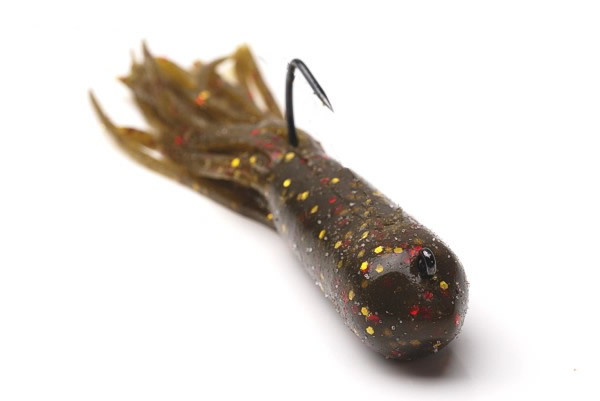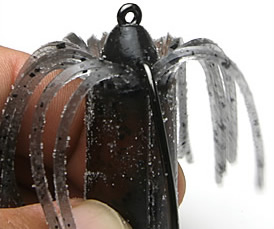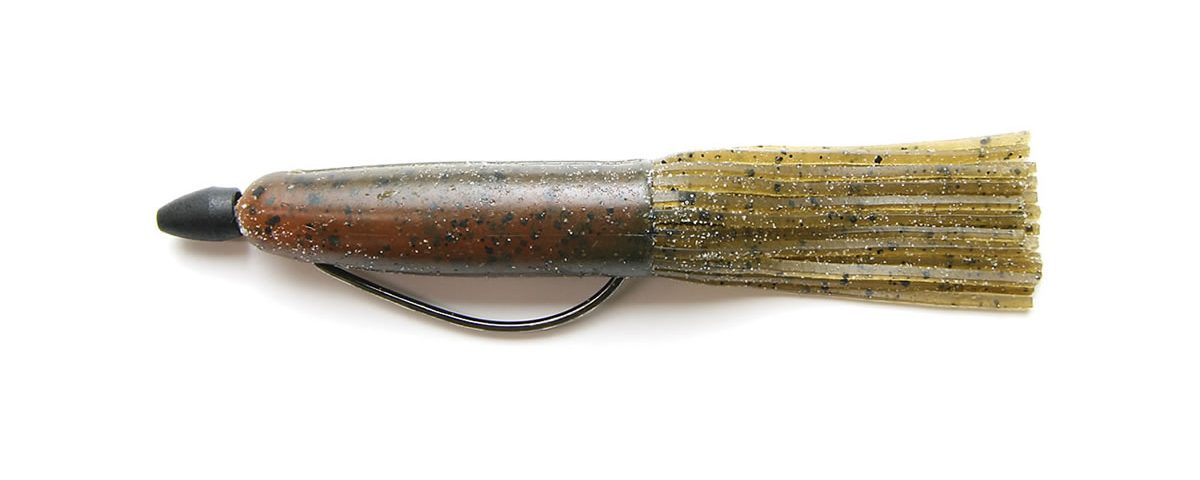
 The original and most commonly used method of rigging a Gitzit was simply to insert a jig head inside the tube and leave the hook exposed. Depending on the weight of the jig head, you would get a different action on the drop. Many anglers out west opted for lighter wide jig heads which produced a wide circling action on the fall. Often refered to as the “Death Spiral”, when rigged this way the Gitzit did an amazing job of replicating a dying or wounded bait fish circling towards the bottom.
The original and most commonly used method of rigging a Gitzit was simply to insert a jig head inside the tube and leave the hook exposed. Depending on the weight of the jig head, you would get a different action on the drop. Many anglers out west opted for lighter wide jig heads which produced a wide circling action on the fall. Often refered to as the “Death Spiral”, when rigged this way the Gitzit did an amazing job of replicating a dying or wounded bait fish circling towards the bottom.
After some time went by other angler began using the tubebait with other rigged techniques:
• Texas Rigged (Punching)- with the weight on the nose of the lure:
In heavy weed and matted vegetation, you can used anywhere from 1/2 oz up to 1 1/2 oz bullet weight. 4″ tubes with a solid head or complete solid body (as found in the Keitech Salty Core Tube) make for a great compact punching bait. Although you don’t have to, if you peg the weight with a toothpick (or other stopper) the tube will come through the thick cover more easily. Extra-wide Gap superline hooks are the perfect match for Texas rigging a tube. Braided line is your best choice for punching a tube through heavy vegetation because it cuts through weed and has nearly zero stretch. This makes setting the hook and horsing a bass out of the thick stuff a much easier task. If you’re concerned about bass being line shy, you can add a fluorocarbon leader, but in most cases that is rarely needed.
• Texas Rigged (Flipping & Pitching):
Using the same Texas rig setup mentioned above, you’re now ready for some stealthy pitching and flipping presentations using a baitcasting rod and reel combo. It’s basically the same presentation you would make with a jig and trailer combo, but the tube seems to slip through cover more easily. For more on pitching, flipping and skipping check out our video:
• Finesse Flipping & Skipping:
Using a spinning rod loaded with 8 – 10 lbs. test line, tie a 2/0 Gamakatsu wide gap hook directly to the line and use 3 1/2 inch tube bait. Then add a small lead weight inside the lure, like a Gitzit Glider.
The lead adds to the overall weight and will assist in bait presentation. Generally 1/8 ounce will do the trick but, if conditions are tough you can reduce the weight to 1/16 ounce.
 Keitech’s new Salty Core Tube is perfect for this technique and you don’t need to add a weight since the bait is already weighted by design. This makes for easy presentation under docks using a skip cast or into weeds using delicate entry as used in traditionally flipping. A simple trick is to extend your pointer finger out near the end of you cast to slow the lure down before it enters the water.
Keitech’s new Salty Core Tube is perfect for this technique and you don’t need to add a weight since the bait is already weighted by design. This makes for easy presentation under docks using a skip cast or into weeds using delicate entry as used in traditionally flipping. A simple trick is to extend your pointer finger out near the end of you cast to slow the lure down before it enters the water.
For Finesse Flipping, try avoiding surface commotion and allow the bait to fall naturally, giving extra line from the spool if needed. When skipping, let her rip… the more noise the better! Always watch your line carefully as oftentimes the bait will be taken on the fall. Many times with skipping bass will hit the bait as it is skipping on the surface.
 If the bait reaches bottom, twitch or drag it back slowly like you do with any other weighted soft plastic presentation. If the lure feels heavy or feels different, set the hook! Hook sets are FREE, so swing away Merrell!
If the bait reaches bottom, twitch or drag it back slowly like you do with any other weighted soft plastic presentation. If the lure feels heavy or feels different, set the hook! Hook sets are FREE, so swing away Merrell!
• Carolina Rigging:
If you Carolina rig… worms, lizards and other creature lures are most likely part of your arsenal. Have you ever tried Carolina rigging a tube though? For an added change-up to your C-Rig (or for any of these techniques), try rigging the tube backwards on an extra-wide gap hook behind.
Talk about something that looks different… drag that puppy around in deep water and watch what happens. 😉




